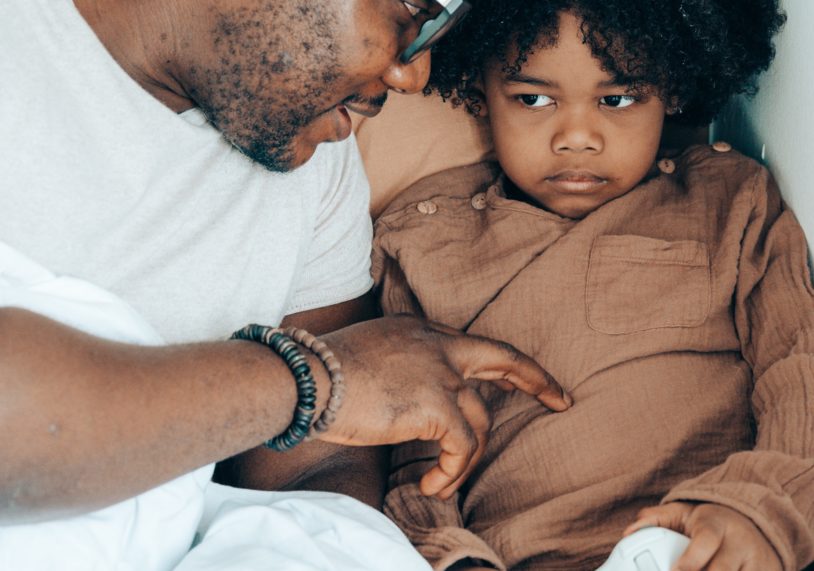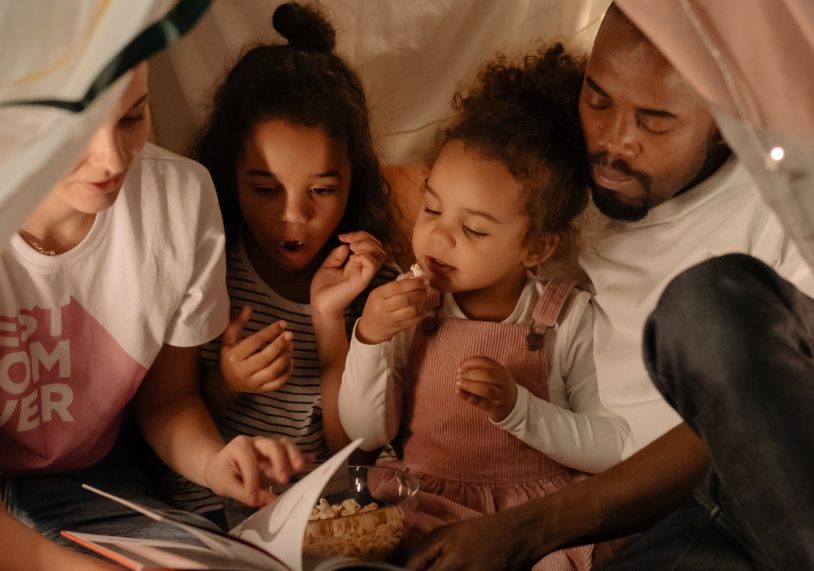9 Tips for Talking to Kids About Race

When it comes to talking to kids about race and issues around race, it can be uncomfortable. But, it is absolutely necessary.
Children have an innocent curiosity about the world. In their eyes, everything is new and exciting. Studies have found that children as young as 6 months can recognize differences in skin tone. Because race is one of the easily identifiable differences we have as individuals, it’s only natural that children are curious as to why people have different skin tones.
As parents and caregivers, it can be tempting to teach younger generations to “not see color.” While the sentiment behind these teachings is in the right place, by failing to see or acknowledge color, we are teaching willful ignorance. Instead, when talking to kids about race we should focus on teaching them to see, acknowledge, honor, and respect all skin colors. Here are 9 tips to help you talk to kids about race.

1. Ask Them What They Know
A child’s mind is like a sponge. They absorb all kinds of information from cartoons, apps, overhearing conversations, etc. With everything that has happened with the BLM movement over the summer, there’s a strong likelihood that kids already have some idea about race and the current tensions surrounding racial injustices. Rather than assume you need to start at the beginning, we recommend asking your child what they know about what makes us different, if they have any questions about skin color, or if they’ve heard about anything going on in the news. This will let you know where you need to start so that you can have a productive conversation.
2. Be Honest While Age-Appropriate
When it comes to talking about race, it is important to be honest with your kids. Hiding information or glossing over important aspects of race is doing a disservice to your child. Instead, you should be honest about race, while keeping information age-appropriate. Younger children will have difficulty understanding what melanin is and why some people have more than others. So for younger children, it is recommended to acknowledge differences in skin color, while also being positive about these differences. With older children, it is important to stress the concept that we can all be similar and different at the same time. It is also important to stress that we shouldn’t generalize about people before we get to know them.
3. Be Open and Willing to Answer Questions
Maintaining an open dialogue is an important part of talking to your kids about race. Regularly discussing the issue of race can have a lasting impact on how comfortable kids are when it comes to dealing with and addressing issues surrounding race. It is our recommendation to take every opportunity possible to discuss the topic. Also, be willing to answer questions whenever they arise, even if they make you uncomfortable. This encourages children to be inquisitive and helps teach them that they can come to you with any questions they may have, whether it is about race or any other topic.

4. Focus on Fairness
The concept of being treated differently because of the color of one’s skin can be difficult for children to grasp. With smaller children, it can be helpful to approach it as a fairness issue. Children understand being treated fairly when it comes to playing games. Discuss racism in the sense that minorities are treated unfairly. A playground metaphor works well here. Telling kids a story about how a minority child is not allowed to use the slide because they look different will help children understand that this behavior is unfair.
5. Don’t Demonize the Police
There is a very real problem when it comes to the discrimination that minorities experience with law enforcement. While these actions are wrong, it is important that you don’t demonize the police when explaining the BLM protests or other race-related events that have to do with law enforcement. This is important because we ultimately want children to feel safe and to go to the police if they are ever in trouble or lost. If you demonize law enforcement, kids may feel as though they have no one to go to if they are ever in trouble.
6. Let Them Feel However They Need to Feel
When discussing race with your children, it’s important to let them process the information and let them feel however they need to feel. Give them the space and freedom to feel angry, sad, confused, or any way they want. However they feel, your child’s feelings are valid. Once they have had time to process, help them sort through their feelings so that they can better cope with such news and issues in the future. This could be as simple as talking to them, engaging them in activities related to race, or attending a BLM protest.

7. Discuss it Often
Whenever kids bring up the topic of race, it is an opportunity to discuss the issue with them. You can also bring up the topic with your kids. Talk about differences with younger children while they are playing with their toys. Encourage them to play with toys with a variety of skin tones and positively acknowledge the differences between them. When doing this, it is helpful to address a number of differences such as skin color, hair color, what they are wearing, etc. Likewise, encourage older children to engage with media that has diverse casting. Discussing race often with children will help them (and you) become more comfortable talking about the differences between people.
8. Make Sure Stories Have Diverse Heroes
One of the easiest ways to introduce the topic of race in your conversations with your child is to ensure that the media they consume has diverse characters. Proactively seek out stories and movies that have main characters with different backgrounds. Use this as an opportunity to teach your kids that everyone can be a hero no matter what they look like. But don’t limit yourself to stories about heroes. Look for simple stories about everyday things that feature a diverse cast of characters.

9. Model Desired Attitudes, Behaviors, and Values
Children are not born racists. They learn from the attitudes and behaviors of those around them and model their own behavior based on what they observe. Therefore, if you want your kids to treat others a certain way, you need to model the behavior first for them to observe. This also means that you need to be aware of your own biases. Take the time to reflect on how you treat others and try to identify any unconscious biases that you may have. Once you are aware of your own biases you can adjust your attitude, behavior, and values for your children to observe.
Get More Tips with Perfect Fit
Talking about race can be uncomfortable, but it is essential to teach children how to discuss and deal with topics surrounding racism and treating others fairly. It is important to teach kids about race, as teaching them to be “colorblind” teaches them to be willfully unaware of how others are treated based on the color of their skin. These tips can help you start these important conversations with your children. Follow Perfect Fit for more helpful tips on dealing with the tough topics with your children.











